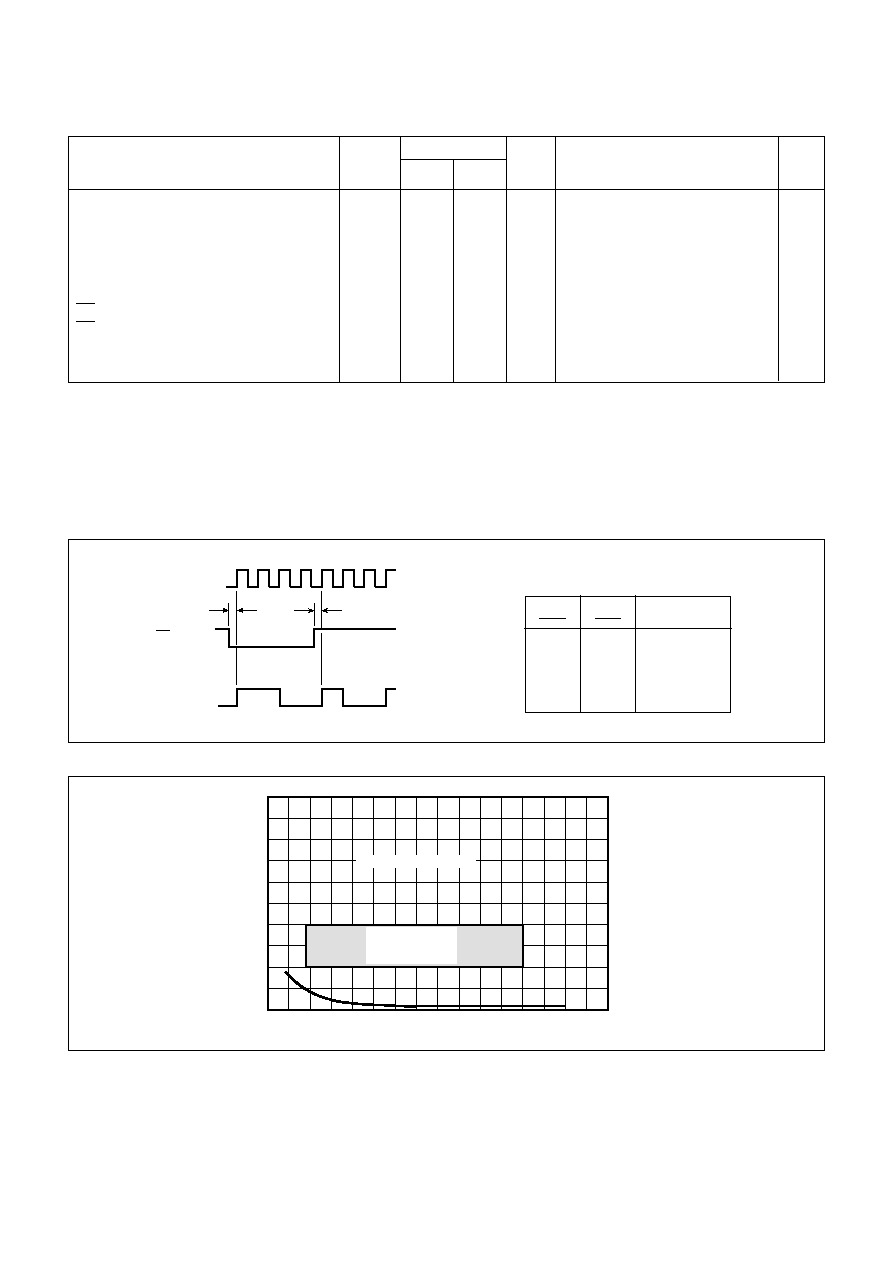 | –≠–ª–µ–∫—Ç—Ä–æ–Ω–Ω—ã–π –∫–æ–º–ø–æ–Ω–µ–Ω—Ç: SP8720BDG | –°–∫–∞—á–∞—Ç—å:  PDF PDF  ZIP ZIP |

ABSOLUTE MAXIMUM RATINGS
Supply voltage
Output current
Storage temperature range
Max. junction temperature
Max. clock input voltage
SP8720
300MHz4
4
4
4
4
3/4
DS3650-1∑2
The SP8720 is an ECL two-modulus divider, with ECL10K
compatible outputs. It divides by 3 when either of the ECL control
inputs, PE1 or PE2, is in the high state and by 4 when both are low
(or open circuit). An AC coupled input of 600mVp-p is required.
FEATURES
s
ECL Compatible Outputs
s
AC-Coupled Input (Internal Bias)
s
Control Inputs ECL III/10K Compatible
QUICK REFERENCE DATA
s
Supply Voltage: 25∑2V
s
Power Consumption: 240mW
s
Temperature Range:
2
55
∞
C to 1125
∞
C (A Grade)
2
30
∞
C to 170
∞
C (B Grade)
Fig. 1 Pin connections - top view
DG16
2
8V
20mA
2
65
∞
C to 1150
∞
C
1
175
∞
C
2∑5V p-p
ORDERING INFORMATION
SP8720 A DG
SP8720 B DG
5962-90577 (SMD)
Fig. 2 Functional diagram
CLOCK INPUT
PE1
PE2
NC
V
CC
NC
NC
OUTPUT
INTERNAL BIAS DECOUPLING
NC
NC
NC
V
EE
DO NOT CONNECT
NC
OUTPUT
1
2
3
4
5
6
7
8
16
15
14
13
12
11
10
9
CONTROL
INPUTS
SP8720
V
CC
(0V)
D1
CK
Q1
D2
CK
Q2
PE1
PE2
CLOCK INPUT
OUTPUT
OUTPUT
V
EE
2
3
1
5
12
8
9
INTERNAL BIAS
DECOUPLING
16
Q2
ADVANCE INFORMATION

2
SP8720
ELECTRICAL CHARACTERISTICS
Unless otherwise stated, the Electrical Characteristics are guaranteed over specified supply, frequency and temperature range
Supply voltage, V
CC
= 0V, V
EE
= 25∑2V 6 0∑25V
Temperature, T
AMB
= 255
∞
C to 1125
∞
C (A Grade), 230
∞
C to 170
∞
C (B Grade)
Characteristic
Maximum frequency (sinewave input)
Minimum frequency (sinewave input)
Power supply current
Output high voltage
Output low voltage
PE input high voltage
PE input low voltage
Clock to output delay
Set-up time
Release time
Symbol
f
MAX
f
MIN
I
EE
V
OH
V
OL
V
INH
V
INL
t
p
t
s
t
r
300
2
0∑85
2
1∑8
2
0∑93
2∑5
3
Min.
Max.
40
65
2
0∑7
2
1∑5
2
1∑62
6
Value
Units
Input = 400-800mV p-p
Input = 400-800mV p-p
V
EE
= 25∑2V
V
EE
= 25∑2V (25
∞
C)
V
EE
= 25∑2V (25
∞
C)
V
EE
= 25∑2V (25
∞
C)
V
EE
= 25∑2V (25
∞
C)
Conditions
Notes
MHz
MHz
mA
V
V
V
V
ns
ns
ns
5
5
5
6
3, 6
4, 6
NOTES
1. The temperature coefficients of V
OH
= 11∑63mV/
∞
C, V
OL
= 10∑94mV/
∞
C and of V
IN
= 11∑22mV/
∞
C.
2. The test configuration for dynamic testing is shown in Fig.6.
3. The set-up time t
s
is defined as the minimum time that can elapse between L
H transition of control input and the next L
H clock pulse transition
to ensure that the 43 mode is obtained.
4. The release time t
r
is defined as the minimum time that can elapse between H
L transition of control input and the next L
H clock pulse transition
to ensure that the 44 mode is obtained.
5. SP8720B tested at 25
∞
C only.
6. Guaranteed but not tested.
L
H
L
H
PE1
L
L
H
H
TRUTH TABLE FOR
CONTROL INPUTS
4
3
3
3
PE2
Division ratio
2000
1600
1200
800
400
0
0 100 200 300 400
INPUT FREQUENCY (MHz)
INPUT AMPLITUDE
(mV p-p)
*
Tested as specified
in table of Electrical
Characteristics
GUARANTEED
*
OPERATING
WINDOW
T
AMB
= 255
∞
C TO 1125
∞
C
Fig. 4 Typical input characteristic of SP8720A
Fig. 3 Timing diagram
2
t
r
t
s
1
CLOCK INPUT
PE INPUT
OUTPUT
2
2

3
SP8720
OPERATING NOTES
1. The clock input is biased internally and is coupled to the signal
source with a suitable capacitor. The input signal path is completed
by an input reference decoupling capacitor which is connected
from pin 16 to ground.
2. If no signal is present the device will self-oscillate. If this is
undesirable, it may be prevented by connecting a 15k
resistor
from the clock input (pin 1) to V
EE
. This will reduce the input
sensitivity by approximately 100mV.
3. The circuit will operate down to DC but slew rate must be better
than 100V/
µ
s.
4. The Q and Q outputs are compatible with ECLII but can be
interfaced to ECL10K as shown in Fig. 7. There is an internal
circuit equivalent to a load of 2k
at each output.
5. The PE inputs are ECLIII/10K compatible and include 4∑3k
pulldown resistors. Unused inputs can therefore be left open.
6. The input impedance of the SP8720 varies as a function of
frequency, see Fig. 5.
7. All components should be suitable for the frequency in use.
Fig. 5 Typical input impedance. Test conditions: Supply Voltage = 25∑2V,
Ambient Temperature = 25
∞
C. Frequencies in MHz, impedances normalised to 50
.
Fig. 6 Test circuit
DUT
450
450
100n
100n
OUTPUTS TO
SAMPLING
SCOPE
V
EE
= 25∑2V
5
8
9
12
16
1
1n
1n
1n
33
33
20
INPUT FROM
GENERATOR
TO SAMPLING
SCOPE
150
j 2
j 1
j 0.5
j 0.2
0
2
j 0.2
2
j 0.5
2
j 1
2
j 2
1
0.5
0.2
j 5
2
j 5
2
5
100
200
300
250
50

4
SP8720
Fig. 7 Typical application circuit showing interfacing
DIVIDE BY
3/4
ECL CONTROL INPUTS
0 = 4
1 = 3
9
8
2k
2k
4∑3k
4∑3k
2
3
12
400
1
16
5
BIAS
ECL10K
OUTPUT
15k
1n
1n
1n
1∑5k
47
V
EE
PE1
PE2
CLOCK
INPUT

5
SP8720
NOTES




